The Museum Collections
Introduction
I. History and Art Collection
1. Icons of the 14th – 19th centuries
icons of the 14th – 17th century
2. Jewelry art of the 14th – 20th century
jewelry art of the 14th – 17th century
jewelry art of the 18th – 19th century
the european silver 14th - 19th centuries
3. Small-size sculptures (works of metal, wood, bone)
XI – the beginning of the XX century
Small-size sculptures 11th – 17th century
Small-size sculptures 18th – early 20th century
enamel of Troitza masters 15-8th – early 20th century
5.Embroidery, lace, textiles of the 14th - early 20th century
icon and ornamental embroidery
gold and silver lace
6.Painting of the 18th – 21st centuries
painting of the 18th – 19th centuris
painting of the 20th – 21st centuris
II.Manuscripts and old printed books of the 14th – 17th century
IV.Lithography of the 18th – 19th century
V.Numismatics
VI.Medals of the 18th - early 20th century
VIII.Archeology collection
IX. Russian folk and applied and decorative art of the 17th – 21st c.
1. Artistic wood
folk carved and painted wood
wooden toys
house carving of Sergiev Posad
Khokhloma and Gorodets painting
2. Artistic textiles
embroidery and weaving
printed textiles and lace
Russian shawls
folk costumes
folk garments
printed cotton kerchiefs
|
Icons of the 14th – 17th cc. (page 2)
|
|
Andrei Rublev’s art greatly influenced the subsequent development of Old Russian painting. The 15th century was the time of brilliant flowering of art when Andrei Rublev heritage was creatively estimated. The icons, depicting the Virgin, present a kind of gallery of beautiful female images. Christian legends used to associate the Virgin with all features of female beauty. But external beauty always implied inner moral beauty. That is why Old Russian icon-painters did not just visualize the most attractive national features, they conveyed the highest spiritual qualities of a person.
|
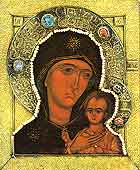
The Petrovskaya Virgin. 15th century.
Donated in memory of Princess Praskoviya Priimkova Rostovskaya. |

The Virgin Eleousa (of Yaroslavl). 15th century. Mounting - 16th century. |
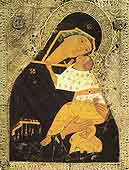
The Virgin Eleousa (Tolgskaya Podgubenskaya). 15th century. |
|
The image of Mary in the icon of Princess Neonila of Rostov is fragile and refined. The small icon with the images of SS. Sophia, Vera, Nadezhda and Lyubov is marked with fine silhouettes, simple composition and decorative color scheme. The icon “St. Leontius of Rostov depicts the 12th century ascetic famous for hard Christian mission in pagan Rostov. The light colors of St. Leontius’s vestment with prevailing shades of white and blue, glittering gold and precious stones correspond to austere and somewhat reserved image.
|
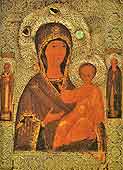
The Virgin Hodigitria. 15th century.
Donated be Princess Neonila of Rostov. |
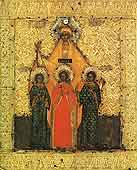
SS. Sophia, Vera, Nadezhda and Lyubov. |
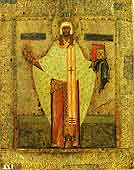
St. Leontius of Rostov. |
|
The icons of the late 15th – early 17th century form an interesting group. They preserve inner expressiveness and spiritual content of the first half of the 15th century, yet they are marked by new features approximating them with icons, painted by Dyonisius, which constituted the main Moscow artistic trend of that time. The works of Dyonisius circle are characterized by elegant forms, elongated proportions, refined color scale. The icon “St. Barbara” from the Church of Intercession of Volokolamsk is a fine specimen of that style. “The Crucifixion” and companion “Old Testament Trinity” were probably influenced by Dyonisius’s art.
|
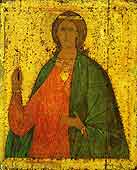
St. Barbara from the Church of Intercession
of Volokolamsk. Late 15th century. |

The Crucifixion. Late 15th century. |
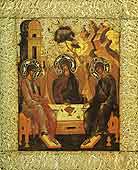
The Holy Trinity. Late 15th century.
|
Moscow art occupied a leading place in the 16th century Russian State. Icon-painting preserved the high artistic level of the previous time, but the content was different. The 16th century was the time of considerable changes in Russian political, economical and cultural life connected with the reforms of Tsar Ivan the Terrible (1533 – 1584). Everything was strictly regulated, exemplums were to be necessarily observed.
At that time the image of Christ Pantocrator was widespread. The Museum icon shows rare individualizes features: an elongated oval face,
piercing glance, highly elevated brows a large aquiline bent down nose. “The New Testament Trinity” and its iconographic variant “Fatherland” are interesting monuments of that epoch.
|
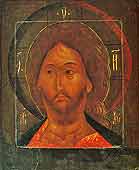
Christ Pantocrator. 16th century. |
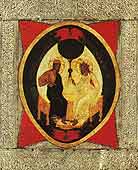
The New Testament Trinity. 16th century. |

Fatherland. 16th century.
|
|


